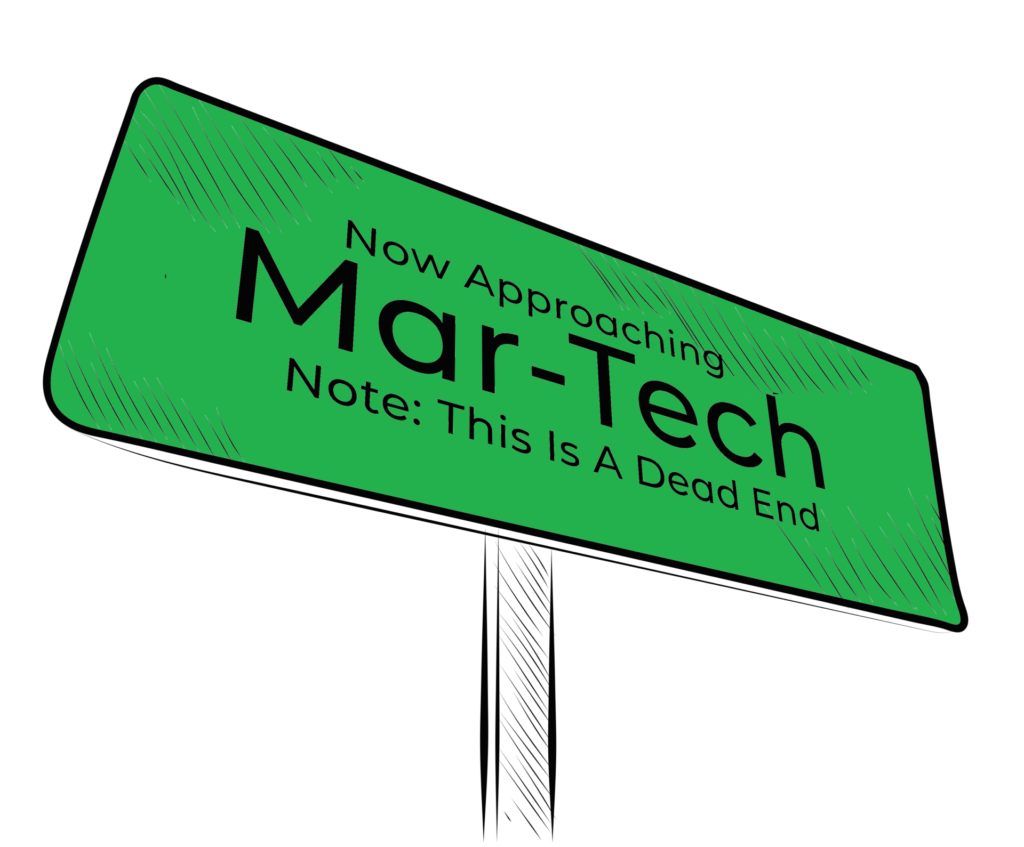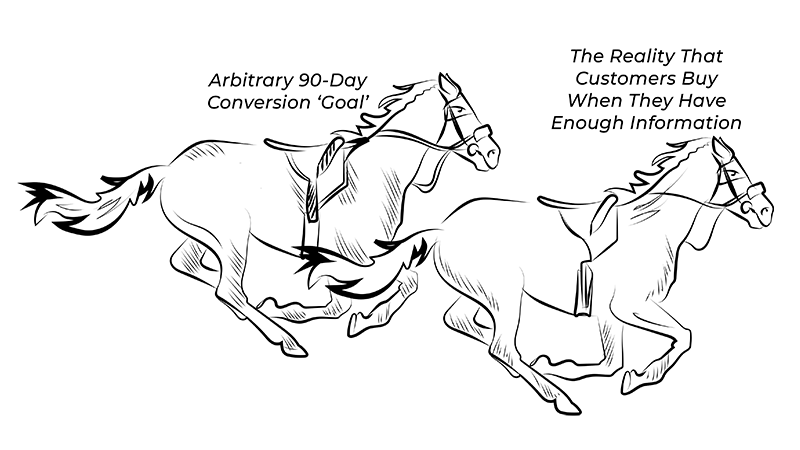Ad-Tech Mitigates Losses It Doesn't Create Marketing Wins
It is the case of the dichotomies of ‘content vs. container,’ ‘effect vs. intent,’. “No amount of analysis ever amounted to a work of art.” Monitoring, analytics, and loss-mitigating technologies pointed at helping a mediocre product and/or website, are about 25% as impactful to sales and visibility as a better/differentiated product, and useful content on a website and should be given 1/4 the volume of attention. But that’s not what happens.

We have a term, ‘exergonic marketing’, at FlashPointLabs. It’s a chemistry term (remember your high-school chemistry labs?) for an energy-producing chemical reaction. Contrast that with ‘energetic marketing’, which is an energy-consumptive marketing effort.
‘Push marketing’ is ‘energetic’ – it requires energy. ‘Outbound marketing’ is energetic’. ‘Pull marketing’, or ‘content marketing’ are exergonic – they leverage energy for distribution and propagation from outside sources. Effectively, you create and share content so appealing that the public – who far outnumber you and who have more collective influence than any budget – does your marketing for you.
If you aren’t cooperating with this great force, you’re losing out.
There are a bunch of mistaken assumptions marketers make when they build complex funnels and monitor and tweak them the day-long day.
We use a fishing analogy a lot. You can get an expensive, quiet, fishing boat; you can buy the best rods and reels; you can buy sophisticated sonar equipment; you can purchase state-of-the-art weather monitors. But there’s no technology that will tell you the right lake to go to, or what kind of bait work best with mackerel in the Spring, in Florida, where you happen to be fishing.
And in the end, just as with a sale, the fish have to bite the hook; they are doing the lifting and making the choice.
Next to an experienced fishing expert with a simple boat, simple rod and reel, in the right space, with great bait, the technology really only has the value of mitigating losses (optimizing), not generating big wins. In a perfect world, you want both: a great product, great content, and also great technical SEO and elegant, effective analytics, to see where churn or dropout is happening. But in a competition between one and the other, product and content are the ‘meat’, and everything else is garnish.
Here are some mistaken assumptions marketers commonly make.
Assumption | Truth |
SEO is advertising or marketing. | SEO can be an effective part of advertising or marketing when the focus is on content and UX, but Search Engine Optimization literally means ‘removing impediments’ to visibility from spiders/crawlers. It is optimizing for visibility. It’s not proactively putting the word out. The net effect may be more traffic, but it’s like cleaning your glasses so you can see better. It doesn’t enhance your vision. It’s like cutting sandbags from a hot air balloon or hoisting an anchor on a boat. |
SEO influences people to come to your site. | SEO is actually a couple of degrees of separation from your audience. Search engine crawlers must find and index you (and rank you, based largely on content), and then the public has to search for and click on links to your site. |
SEO is mostly technical. | With the exception of platform speed, which is actually improved by fewer technical integrations, SEO is almost entirely about content and copy these days. If you have basic tags, you’re fine. Google is looking at visits, backlinks, time on page, and the actions of actual human beings, to determine the visibility or SERP for a given page. Next to copy and content, technical SEO barely ranks. |
SEO can be ‘gamed’; you can pay people to ‘rank no. 1’ for a given keyword, with no downside. | We often say “There are 15,000 Ph.D.’s at Google. You aren’t going to outsmart them.” The history of search engine algorithm versions is really a history of the arms race between webmasters using gray and black hat practices to get unwarranted visibility and Google’s engineers adjusting the algorithm to set things right again. At this point, AI is writing algorithmic changes; they are just approved by humans after testing. If you do manage to cheat Google, your domain will likely be blacklisted for a time once they find out. Since leads/traffic/customers have o click a link to go to your site, this mentality is also suggesting a given company can fool or trick customers, who are always collectively smarter than a given company, and whose agency is required for all engagement and commerce. It’s a disrespectful way to look at your demographic. |
| Companies can grow sales through technology. | As with SEO, you can really only mitigate lost sales. SEO (not losing visibility you would otherwise have), hot spot analysis, UX analysis, A/B testing, friction point analysis, falloff/dropout analysis, and CRO (conversion rate optimization) are all about not scaring away leads that are already there. |
| The Buyer’s Journey (or Buyer Journey if you prefer) can be controlled through mar-tech or ad-tech. | You can use tags, tracking, analytics tools, data aggregation and analysis tools until your heart’s content, and a) your model will never accurately predict what happens in the real world, and b) it will come at a time/opportunity cost to other efforts. In other words, you can spend all day studying the tides, and they’ll still surprise you, or you can get the basics, hop on your surfboard, and get going. |
| A company can simply reshuffle their contents, or optimize SEO – not make product or copy or content changes – and see substantially more sales. | Since traffic, engagement, and sales are determined by consumers, if their ‘take’ or experience remains the same, the best you can do with ‘reshuffling’ mediocre product offerings is to achieve small gains in these areas. As stated above, you can reduce churn somewhat with a reorganization, but the gains will be modest, especially compared to inspired product or service design changes, or a better website. |
| Content and copy and UX aren’t indispensable because they are determinative. Any ‘optimizations’ will result in gains on par with those achieved through a better product, a better site, or both. | In our experience, as a function of combined budget and time, branding/messaging (which we always pair with content and copy rollouts), and/or product or service improvements offer roughly 4x the gains of various ‘analytics’ and ‘technical’ solutions. Research shows that ‘pull’ or ‘inbound’ or ‘content’ marketing is roughly 9x as effective as ‘push’ or paid marketing. |
All these assumptions are wrong. And yet this is how most marketers market: They are using the tools, but not really marketing.
Marketing technology – tools used to monitor and tools used to ‘push’ messages, and ‘push’ leads to buy:
- Present an opportunity cost that distracts from improving a product, website, or creating helpful content that pulls traffic, leads and sales.
- Dominate marketers’ time and become a job in themselves.
- Tend to objectify customers.
- Inspire overconfidence in marketers, who succumb to the belief that watching/monitoring events is somehow controlling them. Even models must be constantly updated. Next to just being awesome, and surfing waves, these types are endless studying the waves, missing the purpose of them. Seeing uninspired execution in hi-resolution is not winning.
If you aren’t giving to receive, aren’t making changes with what you give or offer – as a product or on your site, with user experience or with content – you’re not thinking it through. You’re asking how to catch more fish with a better rod, often in the same location in the same lake – when it’s the *bait* that is determinative.
Mar-tech and ad-tech have their place. Here’s some good ways to know if you’re obsessing too much on the technology at the cost of actually winning.
If you’re spending a lot of time:
- Looking for ad platforms that get more clicks;
- Altering your ads – that are informative and which don’t have offers – to get more clicks;
- Tuning your bid strategies, ad groups, and other technical aspects of your paid ads;
- Better monitoring;
- Integrating your monitoring or analytics into a ‘hub’;
- Constantly updating your predictions and models;
- Creating weekly, monthly, or quarterly lead and sales targets;
- Optimizing conversions of leads you’ve gathered;
- Automating email to keep leads engaged;
- Improving sales enablement to close more leads;

…and you’re not considering either a) how to improve your product (ideally using consumer feedback and surveys), or b) generating content that pulls leads rather than using technology to sell more of the people you’ve pushed your ads in front of, you’re missing an opportunity. Technology has gone from being a ‘good servant’ to being a ‘cruel master’.

All the stacks, integrations, hubs, and constant monitoring and updating eventually supplant the job of marketing, which should be attracting MQLs and closing SQLs. Marketers seldom recognize that managing a marketing stack is not marketing.
We’re not saying you shouldn’t use paid ads, or watch ad budgets; we’re not saying you should not use automation, analytics dashboards or monitoring tools, or ask yourself why leads are falling off from initial conversions to SQLs. We’re not saying ‘scrap your stack’.
Here’s what we’re saying:
- Recognize the limitations of the technology;
- Focus on what you’re giving, not taking more from people;
- Don’t go crazy trying to monitor, measure or predict;
- Don’t go crazy trying to control, steer or corral people;
- Make a great product and a great website. Help people with your content.
- Google will love you after everybody else already loves you;
- Make these tools a servant, and not a master;
- Put 4x the time and money into copy, content, and product improvement, since that’s where the returns come from;
- And lastly, we’re saying there’s an opportunity cost for fiddling with all this technology. You’re not making more substantial improvements when you’re working on stacks and funnels.
A good press story from a product innovation is free and can produce many times the traffic and leads gotten from paid modalities.
Great copy and content produce at 9x the rate of paid modalities.





